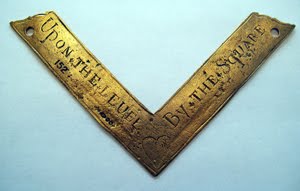WBro Damien drawing heavily from many sources.
The Baal's Bridge Square was discovered in 1830 during the excavation of Baal’s Bridge’s foundations in the City of Limerick in Ireland. Brother James Pain, architect and engineer of Limerick, was contracted to re-build Baal's Bridge and on taking down the old bridge discovered the square in the northern land pier of the old. The date of the construction of the earlier bridge is not known but it’s existence was noted in records of 1558 at the proclamation of Queen Elizabeth. Then it was called Tide-bridge according to Rev P Fitzgerald writing in 1827. It is the oldest Irish artifact of Speculative Masonry and one of the oldest Masonic artifacts in the world. The date 1507 is inscribed on the Square. “The position in which the square was found indicates that one of our Masonic customs, still in vogue, was practiced in Ireland over 400 years ago. The sketch hereunder of the square is an exact facsimile... reproduced from a rubbing, a matter of some difficulty owing to the metal being much corroded....” In the 1905 book by H. F. Berry, “The Marencourt Cup
and Ancient Square.” Brother Berry records that “Ball's (or Baals) Bridge is a beautiful structure, of a single arch,
built in 1831, to replace an ancient bridge of the same name, which consisted
of four arches.... “
The old brass square Pain discovered was much eaten away, however the shape, size, and formation of the engraving on both sides were easily traced. There are two holes in each end suspected to be for the purpose of hanging the square from a collar. There is a heart on each side on the outer angle of the square. In 1842 Brother Furnell printed a short note on this relic accompanied by a sketch of the square. He says that Bro. Pain, in 1830, had been contractor for re-building Baal’s Bridge in Limerick giving details of its discovery. In the facsimile sketch Bro Furnell puts the date as 1517, which is a mistake as the square bears the date 1507. The Builder Magazine was published monthly by the American “National Masonic Research Society” between 1915 to 1930. It is often described as the best Masonic magazine ever published. There are 185 issues which include thousands of articles on Freemasonry, and, although some are dated, it remains an excellent source for Masonic study. It’s available online for free. The Builder published "The Baal's Bridge Square" in 1929 by Bro. Philip Crossle, and then "Some New Facts About The Baal's Bridge Square" By Bro. J. Hugo Tatsch in 1930. The word Baal might raise an eyebrow. It is a name used in 17th Century occult writings. Baal was one of the seven princes of hell, drawn from the Cannaite deity Baal mentioned in the Hebrew bible as the primary god of the Phoencians. The worship of this god known as Baal extends back to the 14th Century BC. However Baal is also a Semetic title meaning "master" or "lord". So in Hebrew, a man is styled baal of a house (Exodus 22:7; Judges 19:22), of a field (Job 21:39), of cattle (Exodus 21:28; Isaiah 1:3) of wealth (Eccles, v, 12), even of a wife (Exodus 21:3; cf. Genesis 3:16). Hence the “Baal” Square might also be called The “Master’s” Square”.The origins of the Bridge’s name are lost. In Elizabethan times, it may have been Tide-bridge, in another chronicle it is "Bald Bridge of Limerick", yet another early name was Boyle’s Bridge, and in yet another Ball’s Bridge. BUT since 1830 and the square’s discovery, The Baal’s (Master’s) Bridge it what the bridge has been known by. Quite fitting after producing such a wonderful Masonic artefact as the Square like those worn by all Masters and Past Masters in our Lodges. It was very lucky that the engineer working on the job was a brother who would have instantly recognised the shape and inscription as something Masonic and this treasurer was not thrown aside into the river as a piece of junk. |
Devotion Newsletter Content > Education & Editorial Articles > Masonic History and Things Historic >



